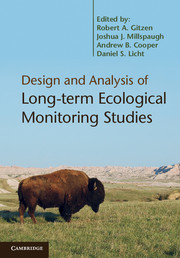Book contents
- Frontmatter
- Contents
- List of contributors
- Foreword: Ecology, management, and monitoring
- Preface
- Acknowledgments
- Abbreviations
- Section I Overview
- Section II Survey design
- Section III Data analysis
- 11 Analysis options for estimating status and trends in long-term monitoring
- 12 Analytical options for estimating ecological thresholds – statistical considerations
- 13 The treatment of missing data in long-term monitoring programs
- 14 Survey analysis in natural resource monitoring programs with a focus on cumulative distribution functions
- 15 Structural equation modeling and the analysis of long-term monitoring data
- Section IV Advanced issues and applications
- Section V Conclusion
- References
- Index
- Plate Section
11 - Analysis options for estimating status and trends in long-term monitoring
Published online by Cambridge University Press: 05 July 2012
- Frontmatter
- Contents
- List of contributors
- Foreword: Ecology, management, and monitoring
- Preface
- Acknowledgments
- Abbreviations
- Section I Overview
- Section II Survey design
- Section III Data analysis
- 11 Analysis options for estimating status and trends in long-term monitoring
- 12 Analytical options for estimating ecological thresholds – statistical considerations
- 13 The treatment of missing data in long-term monitoring programs
- 14 Survey analysis in natural resource monitoring programs with a focus on cumulative distribution functions
- 15 Structural equation modeling and the analysis of long-term monitoring data
- Section IV Advanced issues and applications
- Section V Conclusion
- References
- Index
- Plate Section
Summary
Introduction
This chapter describes methods for estimating long-term trends in ecological parameters. Other chapters in this volume discuss more advanced methods for analyzing monitoring data, but these methods may be relatively inaccessible to some readers. Therefore, this chapter provides an introduction to trend analysis for managers and biologists while also discussing general issues relevant to trend assessment in any long-term monitoring program.
For simplicity, we focus on temporal trends in population size across years. We refer to the survey results for each year as the “annual means” (e.g. mean per transect, per plot, per time period). The methods apply with little or no modification, however, to formal estimates of population size, other temporal units (e.g. a month), to spatial or other dimensions such as elevation or a north–south gradient, and to other quantities such as chemical or geological parameters. The chapter primarily discusses methods for estimating population-wide parameters rather than studying variation in trend within the population, which can be examined using methods presented in other chapters (e.g. Chapters 7, 12, 20). We begin by reviewing key concepts related to trend analysis. We then describe how to evaluate potential bias in trend estimates. An overview of the statistical models used to quantify trends is then presented. We conclude by showing ways to estimate trends using simple methods that can be implemented with spreadsheets.
- Type
- Chapter
- Information
- Design and Analysis of Long-term Ecological Monitoring Studies , pp. 253 - 278Publisher: Cambridge University PressPrint publication year: 2012
- 19
- Cited by

